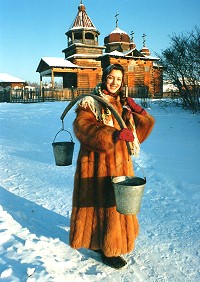| Origin & Development | |
|
Legends & Fairy tales • Earth's Crust Thickness • Underwater Relief • Landscapes • History & Formation • Seismic Activity • | |
| History of Lake Baikal | |
|
History of Explorations • Inhabitants & Settlers • First maps of Baikal • Archaeological Sites • | |
| Lake Baikal Climate | |
|
Introduction • Fogs • Winds & Waves • Ice Conditions • | |
| Fauna & Vegetation | |
|
Mammals • Baikal seal - Nerpa • Ichthyofauna • Invertebrates • Vegetation • | |
| Water of Lake Baikal | |
|
Colour • Transparency • Temperature • Pressure • Depth • Currents • Budget • Chemical Composition • Pollution • | |
| Recreational Areas | |
|
Circumbaikal Railway • Peschanaya Bays • Olkhon Island • Chivirkuysky Gulf • Wooden Irkutsk • Trans-Siberian Railway • | |
| People of Lake Baikal | |
|
People of Siberia • Buryat nation in Baikal • Russians in Baikal • | |
|
| |
Russians at lake Baikal
Russian villages were usually close to the settlements of the "inozemtsy". After some time mixed settlements sprang up, which was the beginning of the blending of the two cultures and ways of life. With the mixing of the two cultures, interracial marriages came into being. The mentality, language and everyday life of the migrants greatly changed. Nevertheless Russian culture prevailed among the Russian Siberians. Here, in Siberia, the primordial carpenter skills proved helpful to the Russian farmer. Behind the Urals the skillful carpenter's axe had a lot of wild, savage ground to break. On the river-banks, as if in old Slavic tall-tales, there began sprouting up log winter cabins, cottages (Russian "izba") with gabble roofs crowned with heavy cornices and ridges, locked fortresses (Russian "ostrogy") built according to the drafts with high palings, and peaked towers decorated with tin eagles and roosters. Bows, wheels and runners were made from common birch. During leisure time, sometimes just for fun, sometimes out of necessity, the people carved spoons, dishes and other utensils. Where Russian settlements sprang up, log structures of living quarters and necessary service buildings became popular among the people of Siberia. The native population appreciated also the migrants' better tools and Russian pattern clothes. The house decorum was rich and varied. Almost all kinds of architectural fretwork decorate platbands, cornices of houses and porches. Vegetation motifs alongside the Buryat folklore elements are prevalent in the ornaments. The unique conditions of life, making an impact on the further generations of the former migrants, left its imprint on their characters and mentality, it generated certain features: steadfastness, reliability... and this has always been associated with the notion "sibiryak" (a Siberian). | |||
